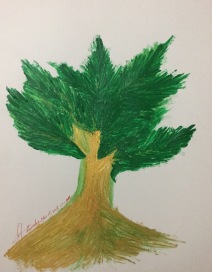www.dropbox.com/s/366auh4etpwp1lj/A Shakespeare Treasury.pdf
Category: Uncategorised
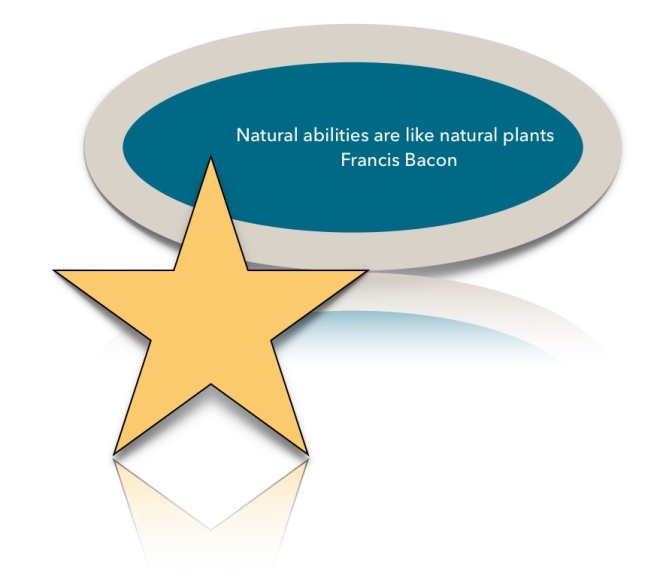
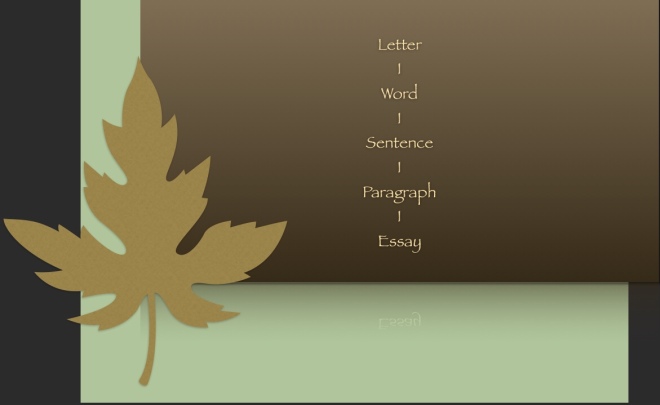
There’s a Good Time Coming
Charles Mackay ( 1814 – 1889 )
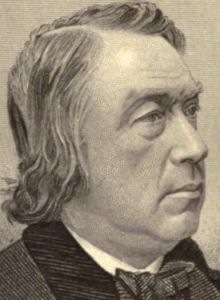
Charles Mackay( 1814 – 1889 ) was a British poet and a journalist. He was born at Perth, Scotland but spent most of his life in France . He is chiefly famous on account of his juvenile songs. In his songs, he has inculcated no vice or immorality but inculcates self reliance, patriotism, and true love,however, his songs are popular and fashionable. They are full of character, courtesies and amenities of life. In Miltonic language they are ” simple, sensuous, and passionate”. His songs some of which, including ” Cheer,Boys,Cheer” became tremendously popular was composed by Russel Henry.
message:
The poem “There is a Good Time Coming ” is about hope and and will that there is a time coming when all will be good and things like justice and thought will prevail rather than injustice, inequality and war but to bring that day one has to be patient and should give his share properly.
Stanza 01:
The first stanza begins with the pleasant news that there is a good time coming but the time is not mentioned as the poet says ” We may not live to see the day” but the earth will sparkle and shine on that coming good time.
Stanza 02:
He says war is not an essential thing to prove the truth because thought is important, opinion is important and in this way any battle can be won but again patience is required.
Stanza 03:
The poet says that in the coming good time between two nations no war but dialogue will prevail as he says “the pen shall supersede the sword.” In the coming good time “right” but not “might” will be the master . The suppressed and oppressed won’t be put down and will be treated fairly by having been given the rights.
Class x Poem: The Man Who Wins
Anonymous
Name if the poet is not known or made public
Message:
The poem gives the message that success or failure is all up to a person’s thinking and state of mind. If one thinks defeated, discouraged,lost he definitely is. In the same way, to rise above you have to be sure of yourself because success is not the destiny of that who thinks himself stronger or faster but of the one who THINKS HE CAN.
Exercise B:
Q1. The poet says that your thoughts of failure put you down and even though you want to win, achieve and be successful but you fear you can’t then surely failure comes to you so to get success, first be sure of it then you will be successful and triumphant.
Q2. Yes, we agree because achievement comes to you when you are sure of it. Be sure that you are going to win otherwise you will be disappointed.
Explanation of the stanzas:
The first stanza describes that one can easily be defeated when he is sure of his defeat or finds himself not courageous enough to do something even though he wants to win from all his heart but he can’t because of his intimidating thoughts of failure.
The second stanza says that will of a person counts a lot. The fear of losing makes you lose as in the practical world success depends on a person’s will and your “will” is your state of mind that makes you a successful person or a loser.
The third stanza says that if you think you are outclassed so you are but first you have to think noble and high and you should be sure of yourself before you win a prize in a contest.
The fourth stanza is conclusive that says in the practical world the faster or stronger isn’t the successful person but no matter how soon or late only that person is successful who believes in his success knowing that HE CAN.
Pattern of the paper for class lx and x
Science and General Group
Regular and Private Candidates
section A
Q1. MCQs ( marks 15 )
MCQS will be based on
article, preposition,synonym and antonyms ( from prose and poetry) punctuation, tenses identification, narration, voice, text and prose knowledge, poetry lines, poets names,etc
section B ( marks 60 )
Q2 a. ( short Q/A any 04 ) prose ( 08 marks )
b. ( short Q/A any 02 ) poetry ( 04 marks )
Q3. Passage ( prose ) ( 06 marks )
Q4.Passage ( poetry ) ( 06 marks )
Q5. Fill in the blanks ( 06 marks )
Q6. Use idioms and phrases in your own ( 06 marks )
Section C ( marks 24 )
Attempt all
Q7. Essay on any one topic ( marks 08 )
Q8.write an application or a letter or a dialogue ( marks 06 )
Q9. Translate any five of the following into English ( marks 05 )
Q10.Unseen passage ( marks 05 )
OR
Write a note
The last Sermon of the Holy Prophet صلى الله عليه وسلم



The Prophet صلى الله عليه وسلم was born in 571 AD at Makkah. He belonged to the noble family of Quraish. The Quraish used to worship idols and did not believe in one God but when our final prophet gave them the message of Allah, they turned against him and gave him lots of problems and difficulties so he left Makkah and migrated to Medina in 622 AD. This event is known as Hijra. In Madina he made an Islamic society based on three principles that Allah has sovereignty, Muhammad صلى الله عليه وسلم is the final Prophet and all Muslims are brothers to one another.
He made the first Islamic law and set rules for all specially for the women who were like a chattel before Islam and were never given respect, our Holy Prophet صلى الله عليه وسلم raised them from a lower state to a noble state.
He gave his last sermon on the 10th year of Hijra in which he addressed a large gathering and once again repeated the message of Allah that there is no god except Allah and He is the only one and no one shares His power and authority.
He said that Allah created all from Adam and Eve and they were made from dust and distributed them into tribes and nations so that they can be distinguished from one another. He made it clear that in the eyes of Allah, the most righteous is the most honourable.Hence no Arab is superior to a non Arab nor is a white man better than a black man only goodness and piety is the mark of superiority. The Prophet صلى الله عليه وسلم crushed under his feet all the false claims to superiority founded on blood or wealth.
He صلى الله عليه وسلم called Muslims brothers of each other and said he fulfilled God’s message leaving among the Muslims the Quran to get the guidance till the Day of Judgement.
Now the Holy Prophet صلى الله عليه و سلم is not among us but we have the Quran and the sunnah to get guidance and goodness in both the worlds
Note:
Q/A are not in the chapter
Q1.when and where was our final Prophet صلى الله عليه وسلم born?
Ans. Our Holy Prophet صلى الله عليه وسلم was born in 571 AD at Makkah.
Q2.what was the condition of the Arabs before Islam?
Ans.The Arabs were in extreme vice.They were vile and wild and were living in the abyss of darkness. They used to quarrel, fight and gamble. Moreover, they buried their daughters alive and didn’t give them any share in the property.
Q3. state the three principles on which the Islamic society was founded.
Ans. See synopsis
Q4.What is Hijra?
Ans. The event of the migration of our Holy Prophet صلى الله عليه وسلم from Makkah to Madina is called Hijra.
Q5.when did our Prophet صلى الله عليه وسلم migrate to Madina?
Ans. Our Prophet صلى الله عليه وسلم migrated to Madina in 622 AD at Makkah.
Q5. What was the condition of the women before Islam?
Ans. Women were in extreme bad condition. They were buried alive because of the fear of dowry and weren’t given any share in the property.
Q6. When and where did the final Prophet صلى الله عليه وسلم address?
Ans. Our final Prophet صلى الله عليه وسلم addressed on the Mount Arafat in the 10th year of Hijra.
Q7.which message was repeated in the sermon by the Prophet صلى الله عليه وسلم?
Ans.The message of monotheism was repeated as well as it was said that Almighty had fulfilled his promise and helped his final Prophet صلى الله عليه وسلم against the forces of evil.
Q8. State the important points of the sermon.
Ans.The sermon was the encompassment of all the teachings of the Prophet صلى الله عليه وسلم and Allah’s commandments. He, the Prophet صلى الله عليه و سلم quoting a verse from the Quran said that all the humanity is the off spring of Adam and Eve who were made of dust and that in the eyes of Allah the most righteous is the most honourable.Thus Allah condemns all the false standards of superiority as Allah honours most the one who is the most pious. He called one Muslim another Muslim’s brother and left the Quran for our guidance till the Doom’s Day.
Q9.What can be achieved after the recitation of the Quran?
Ans. We will achieve our former greatness in the world by the recitation of the Quran.
Q10.what did the Holy Prophet صلى الله عليه وسلم give to us?
Ans. He gave us the message of Allah and the Quran and his Sunnah.
End of chapter
Shah Abdul Latif
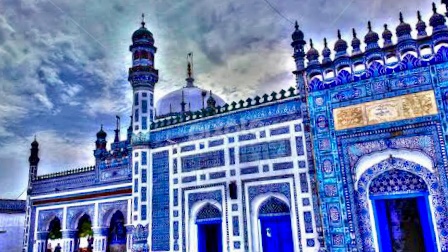
Synopsis:
The chapter begins with an introductory paragraph regarding religion that Islam is a peaceful religion and Allah sent the last Prophet صلى الله عليه وسلم as a blessing to the whole humanity who’s teachings were followed by many of his followers in every period and in the whole world. After our Prophet صلى الله عليه وسلم his companions and the saints spread the message of Allah and brought many non Muslims to the fold of Islam.
In the second para there are the names of different saints whose shrines are located in different parts of Pakistan and here are some notable names:
Lahore: Data Ganj Bukhsh and Mian Mir Sahib
Pak Pattan: Baba Fareed
Multan:Ghous Bahaul Haq
Sindh: Shah Latif and Qalandar Lal Shabbaz
The chapter’s main focus is Shah Abdul Latif who is a worthy saint of Sindh. He was born in 1102 in Hala Haveli. When he was born Aurangzeb was the monarch and when Latif’s ancestors migrated to Sindh Tamerlane was ruling Sindh. They hailed from Hirat, Afghanistan. The culture of Sindh was liked by his forefathers and they made it their home forever. The family became famous when a son named Shah Abdul Latif later known as Lal Latif was born to Syed Habib Shah.
Shah Latif was a sensitive child by nature and he had spirituality in his nature as well as he was quite inclined to nature and this tendency made him a poet but he was not confined to poetry only as he was a thorough learner and soon emerged as a scholar of Arabic and Persian. He had a different mind that’s why even marriage couldn’t stop him to seek religion in the more deeper way so when his father passed away, he left the house and went to live on a raised surface of sand at a distance from his house called “Bhit” in Sindhi and started meditation. His constant and frequent stay made people realise that he was not an ordinary man but was a saint so due to the association of that mound he came to be known as “the saint of Bhit” or “Bhitai ” in Sindhi and from that day on he is known by that name.
By the time Latif ‘s fame spread far and wide. He was equally famous among the people because of his prayer and kind ways with the people. Shah Latif ‘s personality’s another side was his to be a musician. He loved music and invented a simple musical instrument called ” Tambooro “. “Tambooro” had a similarity with an Arabic musical instrument with the difference of number of strings. Tambooro had one string and the Arabian instrument had two or three instruments. It is immensely popular all over Sindh and all play and sing Latif ‘s poetry on it.

Shah Abdul Latif breathed his last breath on the mound and was buried there. Ghulam Shah Kalhoro, a devoted follower built a shrine over his grave, now scores of people pay homage to him coming here. Latif’s lovers collected and published an omnibus of his poetry named “The Resalo of Shah Latif ” or “Shah jo Resalo”. Its major attraction is its simplicity of language and its worldwide translation and above all his poetry has been composed into music that is another quality of his poetry- his music that can make one move without even knowing the language.
14th of Safar, is a day of celebration for the Latif’s devotees who come from far off places and celebrate his Urs with full devotion and affection and pay homage to their endearing saint by singing his poetry on Tambooro and dancing in ecstasy. Learned men read papers and throw light on the life and work of Latif.
For the devotees of Latif many arrangements have been made like a library, a rest house and a museum. Latif leaves behind him nothing but a message of love and fraternity and making Allah happy by our good deeds.
Q/A are not in the book, see below:
Q1.What are the qualities of Latif ‘s poetry?
Ans. The qualities of Latif’s poetry are as follows:
1. It is simple. 2. Has been translated into many languages on account of its universality and spirituality. 3. Has been turned into music and has the power to make anyone dance in ecstasy even to one who is not acquainted with the native language Sindhi. 4. It is in common language so the message is easy to be understood. 5. Latif’s poetry is religiously followed by his devotees as it gives the message of fraternity, harmony and Piety.
Q2. What is the message of Shah Latif?
Ans. See the last para of the chapter on page 11.
Q3.What kind of religion is Islam?
Ans. Islam is a religion of peace, brotherhood and equality that connects one human being to the other and rejects cruelty and ruthlessness and due to this this religion spread far and wide.
Q4.who came as a blessing to the mankind?
Ans. Our Holy Prophet صلى الله عليه وسلم came as a blessing to mankind who became so merciful and kind to them and they came near to him and his this tradition passed on to his followers without the difference of time and space and in this way people embrace Islam.
Q5. Describe the names of the saints and their shrines which are located in different parts of Pakistan.
Ans. See the second para on page 7.
Q6. When and where was Latif born?
Ans. Latif was born in 1102 Hijra in a small village called Hala Haveli.
Q7.who was ruling Sindh when Latif ancestors migrated to Sindh and who was ruling when Latif was born?
Ans. See synopsis.
Q8. What was like Sindh when Latif’s ancestors migrated to Sindh from Herat?
Ans. Sindh was the seat of Muslim culture and tradition at that time. Latif’s ancestors liked it so much and decided to make it their home.
Q9. What made the ancestors of Latif remember?
Ans.The birth of Latif to Syed Habib Shah made the ancestors of Latif remember as he became a saint and was showered with love by the devotees.
Q10.What aroused Latif’s feelings?
Ans. The beauty of the nature aroused Latif’s feelings and he turned towards spirituality and deep thinking.
Q11. In what Latif was keen on acquiring except poetry?
Ans. He was keen on acquiring knowledge except poetry. He became a scholar of Arabic and Persian.
Q12.when and why did Latif leave home?
Ans. Latif left home when his father died as his heart had turned more into devotion and spirituality.
Q13.where did Latif go to live and how long?
Ans. He went to live on a mound of sand called Bhit in Sindhi and also died there.
Q14. Why is he called Bhitai?
Ans.Latif is called Bhitai because he spent his life on a mound of sand inSindhi and died there on account of this he became famous all over by the name of Bhitai or Shah Latif of the mound.
Q15.why did people attract towards Latif?
Ans. People attracted towards Latif because of his kind nature and gentle ways.
Q16. How did Latif start composing poetry?
Ans. Latif started composing poetry because near the mound there was a natural lake and the beauty of the nature and calmness and serenity of the atmosphere filled his heart with love of God and he started composing poetry in His praise.
Q17.Why and which musical instrument did Latif invent?
Ans. Latif invented Tambooro seeing the difficult music of his time as he was an avid admirer of simplicity so he made the music simple by his own invention.
Q18.How was Tambooro different from the Arabian musical instrument?
Ans. Tambooro had only one string and the other musical instruments had two or more strings.
Q19.what does the white dome represent?
Ans. The white dome represents Purity and dignity of Latif’s personality.
Q20.who built his tomb?
Ans. See synopsis
Q21.what has been embedded to the shrine?
Ans. A library, a rest house and a museum are embedded to the shrine so that visitors, scholars and researchers can get the most of it.
End of chapter
Moen jo Daro

Mound of the dead or مردوں کا ٹیلا
The information below has been taken from Wikipedia 

Synopsis
Mohenjo-daro is located west of the Indus River in Larkana District, Sindh, Pakistan, in a central position between the Indus River and the Ghaggar-Hakra River. It is situated on a Pleistocene ridge in the middle of the flood plain of the Indus River Valley, around 28 kilometres (17 mi) from the town of Larkana.
The ruins of the city remained undocumented for around 3,700 years until R. D. Banerji, an officer of the Archaeological Survey of India, visited the site in 1919–20, identifying the Buddhist stupa (150–500 CE) known to be there and finding a flint scraper which convinced him of the site’s antiquity. This led to large-scale excavations of Mohenjo-daro led by Kashinath Narayan Dikshit in 1924–25, and John Marshall in 1925–26.
Design or plan of the city:
The city is divided into two parts, the so-called Citadel and the Lower City. The Citadel – a mud-brick mound around 12 metres (39 ft) high – is known to have supported public baths, a large residential structure designed to house about 5,000 citizens, and two large assembly halls. The city had a central marketplace, with a large central well. Individual households or groups of households obtained their water from smaller wells. Waste water was channeled to covered drains that lined the major streets. Some houses, presumably those of more prestigious inhabitants, include rooms that appear to have been set aside for bathing, and one building had an underground furnace (known as a hypocaust), possibly for heated bathing. Most houses had inner courtyards, with doors that opened onto side-lanes. Some buildings had two stories.
Museum:
There is a museum in which the objects discovered from Mohenjo – daro has been placed. There are toys, the head of a bull used as a seal , tools, the statue of a dancing girl that shows their art and culture and the statue of a priest that reflects their religion, painted pottery, jewellery, carts, etc.
Reason of destruction:
The city of Moenjo daro destroyed there might be an earthquake or they were attacked from the north.
Language:
The language of Moenjo daro is a mystry. The language experts are trying to decipher the language. After it is deciphered, more can be known.
Tourism:
Since its discovery Moenjo daro has been the centre of attraction for the tourists, researchers and archaeologists who come to the site and see this first ever well planned city.Moenjo daro needs more research so that much can be known about this city as only 10% has been discovered as well as care because it is decaying on account of rains and water so that the heritage of Sindh can be preserved.
Q/A are not given in the book
Q1.What do you know about Mohenjo Daro?
Ans. See synopsis
Q2.Who was sir John Marshall?
Ans . See heading of Sir John Marshall.
Q3. How was Mohenjo daro discovered?
Ans. It was discovered when some villagers found some pieces of old pots from the mound of sand and reported to Sir John Marshall who was director General of the Archaeological Survey of India. He ordered an excavation and in this way Mohenjo daro discovered.
Q4. What objects are placed in the museum of Mohenjo daro?
Ans. See the heading of museum.
Q4. What is the reason of the destruction of Mohenjo daro?
Ans. See heading reason of the destruction.
Q5.what is the meaning of Mohenjo daro?
Ans. See synopsis.
Q6. What is the design or plan of the city of Mohenjo daro?
Ans see the heading design or plan of the city.
Q7. Where is Mohenjo daro located?
Ans. See synopsis
Q8. What is the tourism scope of Mohenjo daro?
Ans. See tourism
Q9. What did Sir John Marshall say about the bricks?
Ans. He Said, ” Perhaps there was once a town or a city which lies under these mounds of clay and sand Let us dig here, may be we shall uncover the remains of an old city”.
10.where was the grain stored?
Ans. The grain was stored in the great hall.
Q11. How do you know that the people of Mohenjo daro were rich?
Ans. The people of Mohenjo daro were rich because they were great traders as the river Indus was close by. They would have travelled so many countries and had a luxurious life.
Q12.What were their crops?
Ans. It seems they had a fertile country-side as wheat, rice and cotton were their main crops.
Q13.what were their crafts?
Ans. The people of Mohenjo daro were skilled craftsmen who worked in gold, silver and ivory. Toys were also made for the children like dolls and carts.
Q14.What do you know about their dresses?
Ans. The seals manifest that the priests and the ruling classes wore long loose dresses.
End of chapter
HELEN KELLER
 Synopsis : the heading given below is also included in the synopsis
Synopsis : the heading given below is also included in the synopsis
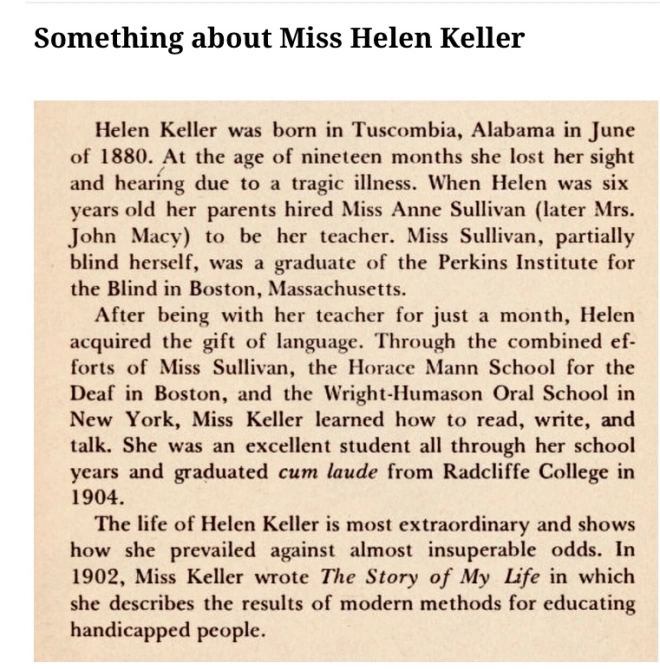
The chapter begins from an introduction that we are lucky to have many blessings like we have eyes to see the world and ears to listen the beautiful voices. Then the story begins saying there are people who are mute and deaf but make their life great because such souls are brave.
See introduction of Helen Keller above
We have read that Miss Anne Mansfield Sullivan was a great influence on the life of Helen. She taught her manners, discipline, skills and also taught her how to read. She taught her different alphabets through sign language.

Later she taught her many things practically like she took her out and made her feel the word water. In this way, she learnt many things. Miss Sullivan took Helen to Miss Fuller’s Horace Mann School when she was eight years old. She would feel the movement of Miss Fuller’s lips during the speaking and then practised it at home by the help of Miss Sullivan and was able to speak by the age of ten.
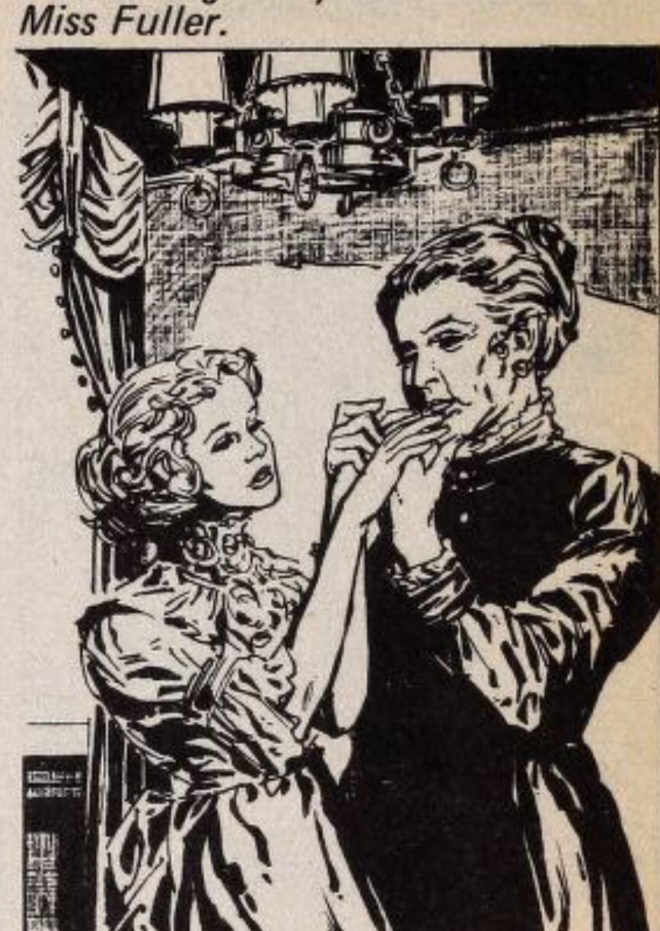
Helen Keller went to Harvard University and passed all her exams easily. She emerged as a symbol of courage and bravery that many people always wanted to meet her. She came to Pakistan in 1956 when she was 76 years old and gave the children here the message of courage and not to curse their fate because nothing is impossible in this world. She visited many schools and appreciated the work of the teachers there.
Helen’s life is an example for us all who feel discouraged and lose heart when some difficulty arrives though we have all the senses. We should thank Allah and should be courageous enough to achieve our goal of life.
Q/A ( see page 30 )
1. Helen Keller was born in Tuscombia Alabama in June of 1880.
2. At the age of 19 months she lost her sight and hearing due to a tragic illness.
3. See synopsis
4. See synopsis
5. Helen Keller visited Pakistan in 1956 when she was 76 years old but was quite active for her age. Helen Keller had come here to help the children devoid of hearing, speaking and seeing.
6. Yes, Helen was a wonderful lady who didn’t feel discouraged and faced her difficulties with bravery and proved that she could do everything. She got education, learnt household skills, travelled widely and encouraged people, motivated them and became a symbol that where there is a will there is a way.
Extra question:
Q1. What was Helen’s message to the blind and deaf children?
Ans. Helen visited many schools in Karachi for the blind and deaf children and appreciated the teachers’ efforts that they were doing for such children. She addressed many gatherings and gave message to the blind and deaf children to always be happy and cheerful and not to curse their fate because they could do anything in this world.
End of chapter
.
